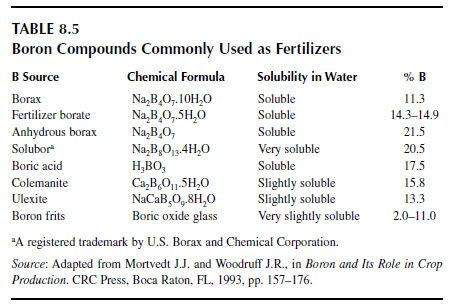Types of Fertilizers
Boron deposits of major economic importance are found only in arid regions of the world where volcanic action brought B and other volatile elements to the surface of the Earth during the Cenozoic era (56). Boron combined with alkali or alkaline earth elements to form rich deposits consisting chiefly of hydrous borates of calcium and sodium. The high water solubility of surface borate deposits precludes their existence in humid regions (56).Concentrated borate deposits of commercial value were formed in continental enclosed basins by the evaporation of waters, which were boron-enriched by volcanic emanations. The locations of the major deposits are primarily in or near zones with histories of volcanic activity in arid regions. For example, a huge borate deposit, the Kramer deposit, was formed in a continental (nonmarine) basin in the Mojave Desert of California, associated with thermal spring activity during the Miocene epoch of the Cenozoic era. Similarly, significant boron deposits were formed in Argentina along the Andean mountain range near Salta. Studies have shown similarities between the hydrous borates of magnesium, calcium, and sodium formed in the Tincalayu deposit in the Province of Salta, Argentina, those in Kirka, Turkey, and the Kramer deposit in California (247).
Before the nineteenth century, Tibet was the world’s source of borates. During the nineteenth century, commercially viable deposits were discovered in Italy, Turkey, South America, and the United States. The largest known borate deposits occur in the interior plateau of Turkey. The second largest occur in the Mojave Desert. Other countries having substantial borate deposits are the former Soviet Union, Argentina, Peru, Bolivia, Chile, Mexico, and China (248). Borax and solubor are the two most common boron fertilizers. Borax (Na2O4B7.10H2O) has been an important commercial mineral for centuries. A list of common fertilizers is shown in Table 8.5.
 |




